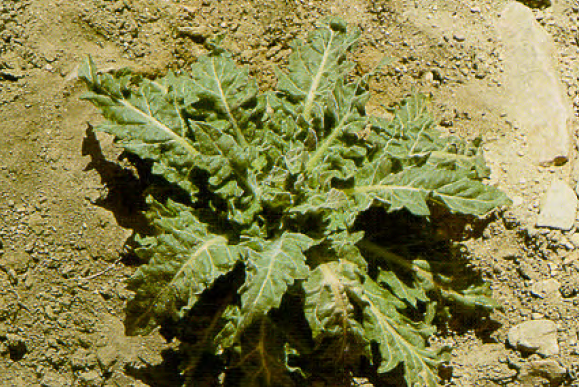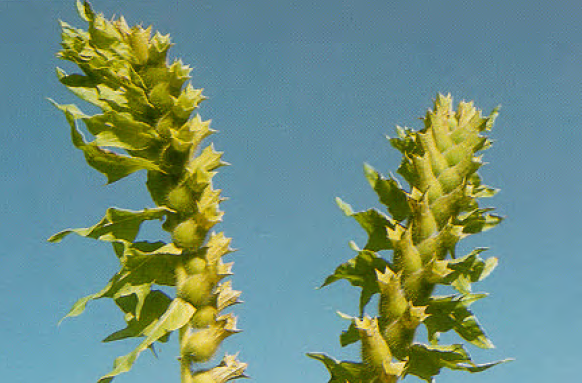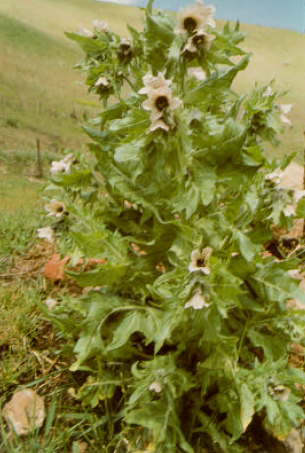Introduction
Introduced from Europe as an ornamental and medicinal herb, Black Henbane (Hyoscyamus niger L.) has spread throughout the United States and is common in pastures, fencerows, roadsides, and waste areas. The alkaloids from all parts of this foul smelling plant are toxic to humans and animals when consumed.
Identification
Black henbane, a member of the nightshade family, may be an annual or biennial and it grows up to three feet tall (Fig. 3). The seed leaves (cotyledons) are lance-shaped to oblong with a few hairs on the bottom (basal) margins. Its lower midvein terminates with a gland. The stalk below the cotyledons is short, and only able to be seen above ground at the earliest stage of growth. The rosette leaves are alternate and often have petioles or stalks almost as long as the blades. The margins are entire to slightly wavy. The veins are prominent and depressed on the upper surface (Fig. 1).

Figure 1. Black henbane rosette with serrated leaves.
The stems of a mature black henbane are erect, leafy, branched, and densely covered with long glandular hairs. Alternate, gray-green leaves are covered with short glandular hairs and are oblong to lance-shaped. They are coarsely toothed to acutely pinnate-lobed, with noticeable pale veins covered with long glandular hairs. Lower leaves are short-stalked and upper leaves are sessile or stalkless. Its foliage has a foul odor. Its taproot is thick and fleshy.
Black henbane flowers from June to September. The brownish-yellow flowers have a purple center and purple veins. The flowers grow on long racemes in the axils of upper leaves. The calyx forms a pineapple-shaped fruit about one inch long with five lobes (Fig. 2). The fruit capsules are egg-shaped and contain hundreds of tiny black seeds that spill out at maturity when the thickened lids pop off. The seeds are deeply pitted, flattened, and contain a higher concentration of alkaloids than the leaves or roots.

Figure 2. Black henbane has pineapple-shaped fruits that contain tiny black seeds.
Habitat
Black henbane is found on disturbed open sites, roadsides, fields, waste places, and abandoned gardens. It grows best in sandy or well-drained loam soils with moderate fertility. It does not tolerate waterlogged soils.
Newly matured seeds may germinate without light, but dormant seeds germinate best with it. Seed can remain viable for four years under field conditions.

Figure 3. Mature plants grow up to 3 feet tall.
Impact
Black henbane is narcotic and poisonous to humans and livestock. Livestock will usually avoid it because of its foul odor and bitter taste, unless other forage is unavailable. Black henbane contains two alkaloids (hyoscyamine and scopolamine) that are used as medicines under controlled conditions.
Management Methods
Prevention
Learn to identify plants and beware of fill dirt, hay, and contaminated crop seed form outside your area. Always sow certified weed-free seeds. Clean equipment after being in an area of infestation, apply sanitation procedures, and control individual or small infestations. Monitor both private and public land for invasions annually. Eliminate this plant where it is found, and revisit the site each year to make sure there are no escapes.
Mechanical Controls
Hand-pulling or digging can be effective if the taproot is entirely removed. In order to prevent seed dispersal, plants with mature fruits should be put in bags after removal. The area must be monitored for new seedlings for at least four years. Mechanical control methods are only effective for small infestations. Wear gloves and protective clothing when handling the plants to prevent rashes.
Cultural Controls
Good vegetative cover considerably reduces the chance of infestation. Black henbane with mature fruits can be burned to kill the seed and reduce spread. It will not tolerate plowing, disking, or cultivation.
Biological Controls
There are currently no known biological controls for black henbane.
Chemical Controls
For large infestations, a systemic herbicide, such as glyphosate, can be applied. Glyphosate is nonselective, but should provide effective control. Monitor the area after application and reapply to regrowth and escapes.
References
Whitson, T.D., ed., L.C. Burrill, S.A. Dewey, D.W. Cudney, B.E. Nelson, R.D. Lee, and R. Parker. Weeds of the West. Jackson, Wyoming: Pioneer of Jackson Hole, 1992. Pp. 564-565.
Noxious Weed Index. CDFA. 19 June 2003.
Graham, J. and Johnson, W.
2004,
Managing Black Henbane,
Extension | University of Nevada, Reno, FS-04-10


